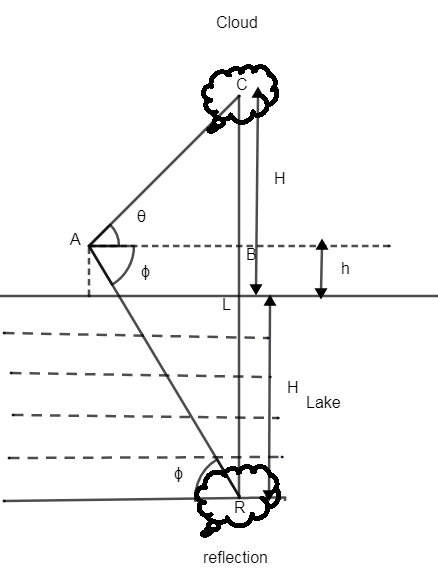Question
Question: The angle of deviation of a cloud from a point h meter above a lake is \[\theta \]. The angle of dep...
The angle of deviation of a cloud from a point h meter above a lake is θ. The angle of depression of its reflection in the lake is 45∘. The height of the cloud
(a)htan(45∘+θ)
(b)hcot(45∘−θ)
(c)htan(45∘−θ)
(d)hcot(45∘−θ)
Solution
Hint: At first take the angle of depression as ϕ, then draw the diagram according to the question given. After that apply the trigonometric ratio tan to both the triangles containing θ and ϕ and then compare them. After comparing, put the value of ϕ as 45∘ to find what is asked.
Complete step-by-step answer:
At first we will do the question in the generalized form which is let’s suppose the angle of depression be ϕ. Let’s suppose height of cloud from ground be H. So, we will draw the diagram as,

Let A be the point from where observations were taken which is h length from the surface of the lake.
Now let’s consider triangle ABC, here we will apply trigonometric ratio which is
tanθ=Opposite side of angle θ / adjacent side of angle θ
Opposite side length which is CB will be calculated as (H - h) and adjacent side will be tanθ is equal to ABH−h.
So, we can write AB as, tanθH−h.
Now let’s consider triangle ABR, here we will apply trigonometric ratio which is,
tanϕ= Opposite side of angle ϕ / adjacent side of angle ϕ
Opposite side length which is BR will be calculated as (H + h) and the adjacent side will be represented as AB.
So, the value of tanϕ is equal to ABH+h.
So, we can write AB as, tanϕH+h.
Now we know that the value of AB is tanθH−h and also the value of AB is tanϕH+h.
So, we can equate and write it as,
tanθH−h=tanϕH+h
Or, H−hH−h=tanϕtanθ
Now, we will apply componendo and dividendo which means that if,
a−ba+b=dc
Then we can write it as,
a+b−a+ba+b+a−b=d−dc+d
Or, 2b2a=c−dc+d
Or, ba=c−dc+d
So, on applying componendo and dividendo we get,
H+h−H+hH+h+H−h=tanϕ−tanθtanϕ+tanθ
Or, 2h2H=tanϕ−tanθtanϕ+tanθ
Or, hH=tanϕ−tanθtanϕ+tanθ
So, H=h(tanϕ−tanθtanϕ+tanθ)
As we took it in the generalized form we got value of H like this now as we know value of tanϕ is tan45∘ as ϕ=45∘. So, the value of H will be,
H=h(1−tanθ1+tanθ)
We know the formula that,
tan(x+y)=1−tanxtanytanx+tany
So, we can put x as 45∘ and y as θ.
So, tan(45+θ)=1−tan45∘tanθtan45∘+tanθ
Or, tan(45+θ)=1−tanθ1+tanθ
So, we can write 1−tanθ1+tanθ as tan(45+θ).
Hence, H is equal to htan(45∘+θ).
So, the correct option is (a).
Note: While doing calculations, one should be very careful as any small mistake can result in a wrong answer. Also, the trigonometric ratios of standard angles should be remembered as they are used very often in such questions.
